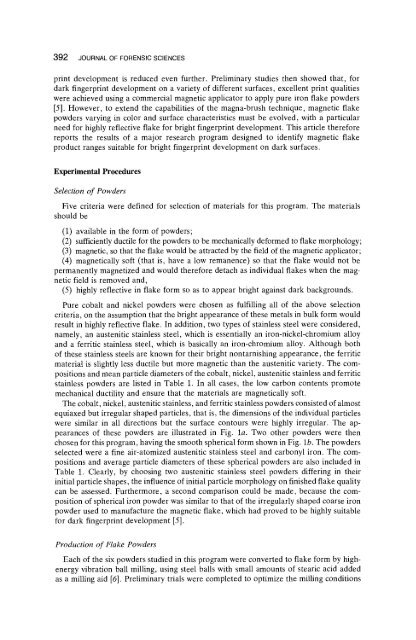Magnetic Flake Powders for Fingerprint Development - Library
Magnetic Flake Powders for Fingerprint Development - Library
Magnetic Flake Powders for Fingerprint Development - Library
You also want an ePaper? Increase the reach of your titles
YUMPU automatically turns print PDFs into web optimized ePapers that Google loves.
392 JOURNAL OF FORENSIC SCIENCES<br />
print development is reduced even further. Preliminary studies then showed that, <strong>for</strong><br />
dark fingerprint development on a variety of different surfaces, excellent print qualities<br />
were achieved using a commercial magnetic applicator to apply pure iron flake powders<br />
[5], However, to extend the capabilities of the magna-brush technique, magnetic flake<br />
powders varying in color and surface characteristics must be evolved, with a particular<br />
need <strong>for</strong> highly reflective flake <strong>for</strong> bright fingerprint development. This article there<strong>for</strong>e<br />
reports the results of a major research program designed to identify magnetic flake<br />
product ranges suitable <strong>for</strong> bright fingerprint development on dark surfaces.<br />
Experimental Procedures<br />
Selection of <strong>Powders</strong><br />
Five criteria were defined <strong>for</strong> selection of materials <strong>for</strong> this program. The materials<br />
should be<br />
(1) available in the <strong>for</strong>m of powders;<br />
(2) sufficiently ductile <strong>for</strong> the powders to be mechanically de<strong>for</strong>med to flake morphology;<br />
(3) magnetic, so that the flake would be attracted by the field of the magnetic applicator;<br />
(4) magnetically soft (that is, have a low remanence) so that the flake would not be<br />
permanently magnetized and would there<strong>for</strong>e detach as individual flakes when the mag-<br />
netic field is removed and,<br />
(5) highly reflective in flake <strong>for</strong>m so as to appear bright against dark backgrounds.<br />
Pure cobalt and nickel powders were chosen as fulfilling all of the above selection<br />
criteria, on the assumption that the bright appearance of these metals in bulk <strong>for</strong>m would<br />
result in highly reflective flake. In addition, two types of stainless steel were considered,<br />
namely, an austenitic stainless steel, which is essentially an iron-nickel-chromium alloy<br />
and a ferritic stainless steel, which is basically an iron-chromium alloy. Although both<br />
of these stainless steels are known <strong>for</strong> their bright nontarnishing appearance, the ferritic<br />
material is slightly less ductile but more magnetic than the austenitic variety. The com-<br />
positions and mean particle diameters of the cobalt, nickel, austenitic stainless and ferritic<br />
stainless powders are listed in Table 1. In all cases, the low carbon contents promote<br />
mechanical ductility and ensure that the materials are magnetically soft.<br />
The cobalt, nickel, austenitic stainless, and ferritic stainless powders consisted of almost<br />
equiaxed but irregular shaped particles, that is, the dimensions of the individual particles<br />
were similar in all directions but the surface contours were highly irregular. The ap-<br />
pearances of these powders are illustrated in Fig. la. Two other powders were then<br />
chosen <strong>for</strong> this program, having the smooth spherical <strong>for</strong>m shown in Fig. lb. The powders<br />
selected were a fine air-atomized austenitic stainless steel and carbonyl iron. The com-<br />
positions and average particle diameters of these spherical powders are also included in<br />
Table 1. Clearly, by choosing two austenitic stainless steel powders differing in their<br />
initial particle shapes, the influence of initial particle morphology on finished flake quality<br />
can be assessed. Furthermore, a second comparison could be made, because the com-<br />
position of spherical iron powder was similar to that of the irregularly shaped coarse iron<br />
powder used to manufacture the magnetic flake, which had proved to be highly suitable<br />
<strong>for</strong> dark fingerprint development [5].<br />
Production of <strong>Flake</strong> <strong>Powders</strong><br />
Each of the six powders studied in this program were converted to flake <strong>for</strong>m by high-<br />
energy vibration ball milling, using steel balls with small amounts of stearic acid added<br />
as a milling aid [6]. Preliminary trials were completed to optimize the milling conditions

















